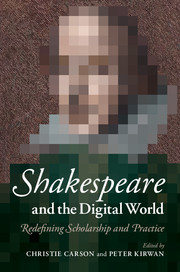Book contents
- Frontmatter
- Contents
- Notes on contributors
- Acknowledgements
- Shakespeare and the digital world
- Part I Defining current digital scholarship and practice
- Part II Defining current digital scholarship and practice
- Half-time: A pause for reflection
- Part III Redefining the boundaries and practices of Shakespeare studies online
- 10 Unlocking scholarship in Shakespeare studies
- 11 Living with digital incunables, or a ‘good-enough’ Shakespeare text
- 12 Shakespeare in virtual communities
- 13 Gamekeeper or poacher?
- Part IV Redefining the boundaries and practices of Shakespeare studies online
- Index
- References
11 - Living with digital incunables, or a ‘good-enough’ Shakespeare text
Published online by Cambridge University Press: 05 July 2014
- Frontmatter
- Contents
- Notes on contributors
- Acknowledgements
- Shakespeare and the digital world
- Part I Defining current digital scholarship and practice
- Part II Defining current digital scholarship and practice
- Half-time: A pause for reflection
- Part III Redefining the boundaries and practices of Shakespeare studies online
- 10 Unlocking scholarship in Shakespeare studies
- 11 Living with digital incunables, or a ‘good-enough’ Shakespeare text
- 12 Shakespeare in virtual communities
- 13 Gamekeeper or poacher?
- Part IV Redefining the boundaries and practices of Shakespeare studies online
- Index
- References
Summary
For Shakespeareans, perhaps the most profound disturbances wrought by the disruptive innovation of electronic print have to do with the way we read, in the classroom and for research. The vectors of disruption to academic reading are comprehensive: a failing purchasing ecosystem for textbooks; emergent differences between reading online, reading onscreen, and reading books; the growth of online editions that test longstanding concepts of textual authority; opportunities and challenges posed by new digital methods of corpus analysis.
These transformations require us to revisit our assumptions about what constitutes a ‘good text’ for study, research and learning. During a period in which our networks and tools of reading are clearly incunables – emergent technologies in a phase of rapid media change – that process of self-assessment seems likely to continue for the foreseeable future. What follows, then, is a core sampling of the challenges and opportunities each of these four text-based disruptions pose for Shakespeareans now. In sketching them, I reflect on how humanists can address our worries about the tradeoffs between ‘good’ and ‘good-enough’ texts. The question we should be asking ourselves is at once a narrower and more generative one. When it comes to discriminating between the texts we choose, craft and promote for larger audiences, we should be asking ourselves: good enough according to what principles and for what purposes? This chapter approaches that question both as an individual and practical problem (touching down in scholarly and classroom anecdotes) and as a challenge of disciplinary practice and identity, emerging especially acutely for Western academic Shakespeare studies in the early twenty-first century.
- Type
- Chapter
- Information
- Shakespeare and the Digital WorldRedefining Scholarship and Practice, pp. 144 - 159Publisher: Cambridge University PressPrint publication year: 2014
References
- 1
- Cited by

